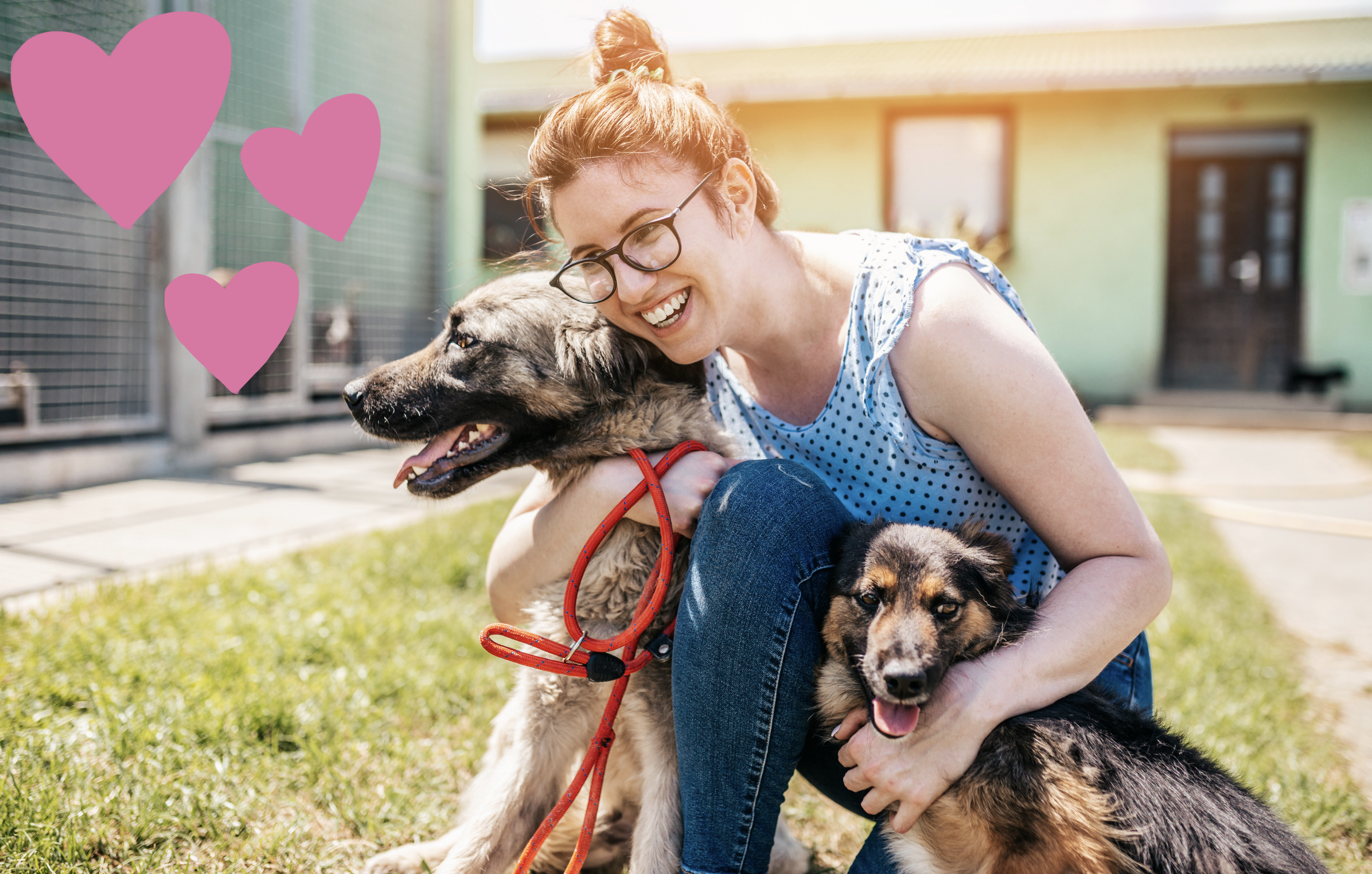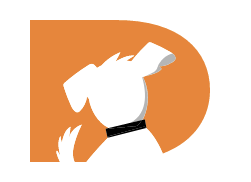7 min read
Finding The Right Rescue Dog: Helping Them Feel At Home
DOGTV Team : Mar 5, 2021 4:09:05 AM

I think everyone agrees for all of us fortunate dog moms and dads: our animal family members became at-home heroes throughout the pandemic. The highlight of 2020? Thousands of orphaned dogs and cats benefited from a worldwide boom in adoptions. That is good for both ends of the leash! I personally cannot imagine coping without my good girl daughters, Penelope & Delilah.
I adopted both my girls. I found Penelope at a street far, amidst a sea of adorable rescue puppies, 11 years ago. I didn’t know much about temperament testing but I lucked out with a friendly, intelligent and affectionate girl who was a perfect complement to our life in the media.
Delilah Jane came along in 2013, and was nothing like what I would have wanted. She had crazy, high energy and was ridiculously aloof—not an easy combination! Delilah was terrified of the water, which was the opposite of my ideal pup, since I’m a surfer and the ocean is my happy place. I had been on a waiting list for a Nova Scotia Duck Tolling Retriever, but after months of fostering Delilah and bonding with her through clicker training, I realized I couldn’t live without her. She is now a dream! She loves the beach, even if she prefers to play in the sand.
Both Penelope and Delilah are my perfect demo dog sidekicks for live events and TV appearances. We have a blast traveling together and they each shine as dog actresses and models. Through time, understanding and positive reinforcement training, I was able to help each of them reach their potential.
Having a dog in your life can pawsitively impact your mental and physical health—science, along with plenty of personal experiences from others—proves this! My girls remind me to stop and make time for daily walks, hiking adventures, and sunset frolics on the beach; they get me outside to exercise and help me disconnect from technology. I’ve learned as much from them as they’ve taught me. When I’m happy, they are some of my favorite people to celebrate with, and when I’m sad, I share a lick of ice cream with them as they console me.
I love hearing about how many aspiring dog parents are making the choice to adopt a new family member, as our lifestyles have changed. Many friends have asked me for advice about finding the right rescue dog match, so I’m here to help! Whether you look for your future best friend in a shelter, or through a locally run rescue group, this is one of the most important decisions you will ever make.
Making the right match can mean decades of fun, joy, and adventure. But if it’s not quite the right fit, it can bring stress, management, and sometimes ultimately heartache, so I’m writing this to help you be as informed as possible, and take the time to do your homework, so you can have the most awesome dog that is right for you and your family.
So how do you know, amongst all the puppies and dogs out there, which one would be the best fit for your home, family, and lifestyle? And how do you ensure the transition from where they are into your home will be as stress-free as possible, and help them to feel they’ve truly found their forever home?
The first thing to consider is what the ideal dog is for you, regardless of its source.
- If you love to run, maybe getting an adult dog that likes to stay active would be a good fit.
- If you have a busy lifestyle and work a lot, then maybe a new puppy isn’t the best due to the time commitment they need.
- Or maybe you just want a couch potato who likes to cuddle!
Likewise, first-time dog adopters may need a different dog than those with more experience, so they don’t become overwhelmed.
What is your lifestyle like, and what are your goals for having a canine companion? It has to be based on more than just, “Oh, that’s a cute-looking dog.” It may be cute, but the temperament and personality of the dog is most important in making the right choice.
Also, remember that a dog is a lifetime commitment, and you will need to budget for everything your dog needs: food, treats, supplies, training and a lifetime of veterinary care. It’s a big responsibility, not only emotionally, but financially.
Whenever people ask me where to look, I like to point them to the Internet. There are many ways to find your perfect match, even in a pandemic! Look on community Facebook pages, connect with neighbors via the NextDoor app, or my favorite: do an extended search by checking off your wish list on Petfinder.com. First, it’s a great way in the day and age of COVID-19 to get a good look at dogs as some shelters may not be open to the public, and they aren’t doing as many adoption events. Besides that, shelters and rescues list their available animals on this site, so you wouldn’t have to drive around or go to a lot of different websites to begin your search. Third, you can also use the filters on its search engine to put in the breeds, ages, etc., for whatever you’re looking for so you can bring up those animals first, saving a lot of time.
Once you have some potential candidates, call the source(s) and ask them for more details. Being honest, open, and candid is crucial here—remember that not only do you want the right fit, but those who facilitate the adoption of animals also want the best fit. Besides telling them about your home and your lifestyle, you will want to ask them about any type of assessment they have for the dog, both behaviorally and medically.
If they train with the dogs, what does the dog know and what are their strengths and weaknesses? What style of training have they used, and do they offer any work with or resources to adopters on training? How does the dog respond to food, other people or children, other animals, and different types of environments? If the dog is in the shelter, have they had the opportunity to be in a home environment to see how they do there? Some shelters do “sleepovers” with volunteers to give them a break and better assess this.
This sounds like a lot of work, and it is—but it’s better to do a lot of work upfront to find the right fit for you and your family. In the meantime, you will want to get your home ready for your potential new pup. You’ll want to make sure you have high-quality food and treats like NumNums, a collar with tags, a leash, a harness, food, and water bowls, toys of all kinds, chew items, crates, and gates (exercise pens for puppies or small dogs can also be very useful), and a comfortable bed.
Make sure there are no potential safety hazards as well
- Put away potentially poisonous or harmful items
- Ensure there are no holes in your fencing and that it is properly enforced
- Clean up and put away your shoes so they don’t get eaten (wink)
- Close doors or gate off areas that are not open for the dog.
- Place your dog’s crate in an area that is quiet and calm, but not far away from everyone else so as to cause any separation anxiety. Most people opt for their bedroom or close by, or in a living area.
If you have other dogs or pet animals, make a plan for a positive first introduction as well. Lots of shelters will require adopters with dogs do a meet-and-greet under their supervision with you to ensure it’s a good fit before officially approving your application and releasing the dog to you. I recommend taking a walk together at a distance where the dogs cannot meet just yet, but are close enough to notice, and get treats for noticing, each other. This helps build a more positive association before allowing them in a safe off-leash area to get to meet each other without the hindrance of leashes. Once you bring your dog home, you should not leave him or her unsupervised with your other pets. The same goes for children.
And once you do get your new dog home, go slowly. You shouldn’t be taking your dog out to dog parks, shopping errands, and to meet all the new people in your life right away. They need time, most of all—time to acclimate to their new home, the people and other pets in their immediate circle, and time to learn their new routine. Be patient and don’t expect the dog to be perfect. It will take time for them to learn and you will need to remember that they also need time to decompress from the stress they may have experienced in a shelter environment.
What you should do is spend time taking walks or hikes, running and playing in your fenced-in yard, and doing puzzle toys, enrichment and positive reinforcement training in the home. Some dogs may be overwhelmed by kisses and hugs so refrain from that, tempting as it may be. The first goals are to let the dog de-stress and learn that you are not a threat, and to build trust with him or her. Making the crate you have a great, safe place for them to be will also help with ensuring everyone’s safety and having success with house training. Feed all their meals in the crate and allow them time during the day for breaks, with chews to enjoy or stuffed Kongs, to help make it more positive.
With the complications of COVID-19 right now, going to a veterinarian is bound to be a little bit more stressful, as most are not allowing people in with their dogs. Choose a good veterinarian and, before your dog’s first official appointment, go there and give them treats out in the lot. You may even call ahead and see if any of the supporting staff is willing to take your dog in and give them treats without any formal checkup, so the dog gets a more gradual and positive introduction prior to the real deal.
And last, but not least, hire a positive reinforcement-based trainer! Whether you find a fab Zoom class, a socially-distanced outdoor class, or can afford private dog training lessons, training is perhaps the best investment you can make into your relationship foundation. Too often, not enough people budget for and consider training a luxury item rather than a cornerstone to a great relationship with their dog.
Make sure whoever you hire for training has an understanding of using positive techniques and refrains from corrections and aversive equipment (such as electronic or citronella collars, prong collars, choke chains and the like). Punishment can break down trust and cause fear, as well as aggression. Your trainer should be committed to making the work fun and positive, and meet the dog and person at their level of knowledge.
Positive reinforcement training has helped nourish such an incredibly deep bond, and it’s why I am so passionate about sharing tips like this with others. I hope my advice helps let me know if you have any questions.
For those of you who are considering adoption, please let me know how it goes! Please also leave a comment about your favorite way they’ve impacted your life!
You can tag us on social @LauraNativo @DogTV or post a comment below! Love & Licks, Laura Nativo, CPDT-KA KPA CTP, www.LauraNativo.com
After a fun day spent with your new dog, cuddle up and watch some DOGTV.
